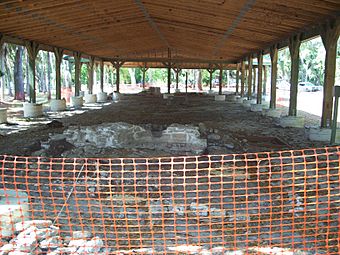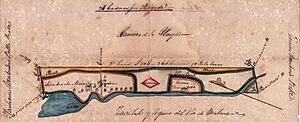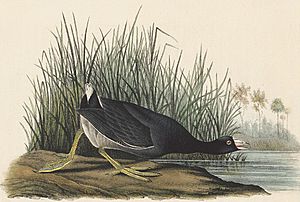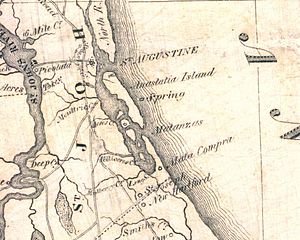Mala Compra Plantation Archeological Site facts for kids
Quick facts for kids |
|
|
Mala Compra Plantation Archeological Site
|
|

Mala Compra excavation site
|
|
| Location | Palm Coast, Florida |
|---|---|
| Area | less than one acre |
| NRHP reference No. | 04000142 |
| Added to NRHP | March 5, 2004 |
The Mala Compra Plantation Archeological Site is a special place in Palm Coast, Florida, where archaeologists study old things. It's on the east side of the Matanzas River. You can find it near Bings Landing County Park in Flagler County, close to State Road A1A. It became a nationally recognized historic site on March 5, 2004.
Mala Compra means "bad bargain" or "bad purchase" in Spanish. This site was once part of a very large plantation system in northeastern Florida. It belonged to Joseph Marion Hernández (1788–1857). From 1816 to 1836, it was a cotton plantation where people were forced to work. The Seminoles burned it down in 1836, at the start of the Second Seminole War.
Archaeologists started exploring the Mala Compra site in 1999. They found the house where Hernández and his family lived when they weren't in St. Augustine. They also found the separate kitchen building. Hernández bought the land for the plantation in 1816. People grew cotton and corn there until Native Americans destroyed the settlement.
Historical records describe the main house as a 1 1/2-story wooden building with a strong foundation. Archaeologists found that the building had a coquina block foundation on one side. The other side was supported by masonry footers. The house was actually bigger than old descriptions said. They found traces of wooden floors, but also concrete surfaces made from a material called tabby.
In 1837, Joseph S. Sanchez told the County Court of St. Johns County what his troops found at the plantation in 1836. They saw many oxen, cattle, and horses. There were also garden areas and cattle pens. He mentioned a large orange grove with 1,500 trees and other fruit trees.
Archaeologists and their helpers found over 14,000 items. These included pieces of pottery, wine bottles, kitchen tools, pipes, hinges, nails, and gun parts. The main house and kitchen areas have been set up for visitors. They offer an interactive exhibit to teach people about history. There are also plans for more research and to protect these important cultural treasures.
Contents
History of Mala Compra Plantation
In 1816, the Spanish government gave Hernández a large piece of land. It was located where Graham's Swamp met the Matanzas River. On this land, he grew about 700 acres of sugarcane. He called this place St. Joseph plantation.
On March 11, 1816, Hernández bought another 800 acres for 1,500 pesos. This land was on the coastal barrier island next to the Matanzas River. It was bordered by land owned by John Bautista Ferreyra. The name "Mala Compra" was already given to this property by a previous owner.
In 1818, Hernández bought another 375 acres from Ferreyra's son, Francis Ferreira. This property was called Bella Vista and was next to Mala Compra. Ferreira was a sea captain who was involved in the trade of enslaved African people in Florida.
The cotton fields at Mala Compra were said to be very sandy, almost like the beach. Yet, they still produced many crops of Sea Island cotton. This land was high hammock land. It was mostly covered with Southern live oak trees.
The Plantation House and Buildings
Hernández's country home was the plantation house at Mala Compra. It was a 1 1/2-story wooden building. It had a coquina block foundation that was 18 by 30 feet and three feet deep. The side facing the river had a long, wide porch. Inside the house, there were two fireplaces made of brick and coquina. The walls were plastered, and the doors were paneled.
The kitchen was a separate building, also 18 by 30 feet. It had a terraced first floor and a loft. The loft was used for drying tobacco. There was also a wooden warehouse for cotton. This warehouse could hold 200,000 pounds of cotton seeds and 200 bales of ginned cotton.
The farm had equipment like cotton gins. These were machines that separated cotton fibers from seeds. Some gins were for one or two horses, and others were larger, 24-foot gins. Horses would walk in a 24-foot circle to power these machines. There were other buildings too, like a corn storage building, a house for the plantation driver, and a privy (outhouse). There were also cabins for the people who were enslaved and forced to work there.
Joseph Marion Hernández's Public Life
Hernández was an important figure in Florida's history. He was Florida's first delegate to the U.S. Congress. He served in 1822 and 1823. He was also the first Hispanic person to serve in the United States Congress.
During the Second Seminole War, he was a brigadier general. He led troops of the Florida Militia. In October 1837, he was negotiating with Seminole leader Osceola. By order of General Jesup, Hernández took Osceola captive during these talks.
From Mala Compra, Hernández wrote a letter on April 15, 1830. It was to Dr. William H. Simmons and was about growing Cuban tobacco. Simmons and John Lee Williams helped choose a central spot for Florida's capital in 1823.
In 1831, the famous artist John James Audubon stayed at Mala Compra for ten days. He was a guest of Hernández. While there, Audubon shot many American coots. He used one male coot to draw the picture for his famous book, The Birds of America.
Plans for a Canal
In 1832, the government of Florida approved a company to dig a canal. This canal would connect the Matanzas Lagoon to Smith's Creek. Smith's Creek was a branch of the Halifax River. The company asked Congress for money and land to help with the project. Five sections of land were set aside for the canal.
The company planned to start the canal at Mala Compra plantation. They would dig it south for about 11 or 12 miles. It would go through a rich, wet savanna, parallel to the coast. The canal would end at Smith's Creek, about four miles north of John Bulow's plantation.
Mala Compra During the Second Seminole War
During the early part of the Second Seminole War, in the winter of 1835 and spring of 1836, the U.S. military took over Mala Compra and St. Joseph plantations. The houses were used and strengthened as military posts. Over that winter and spring, different groups of soldiers occupied, left, and then reoccupied both places. The troops took and ate large amounts of corn, hay, sugarcane, and cattle found on the farms.
In the spring, the Seminoles took advantage of a time when the soldiers had left. They burned all the important buildings on the sugarcane plantation. At Mala Compra, they burned the cotton warehouse. This warehouse had been prepared and used as a defensive fort. The Seminoles captured some of the 80 enslaved people on the plantation and forced others to leave.




